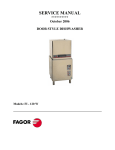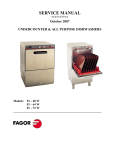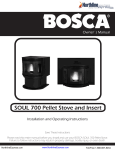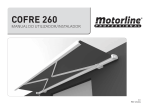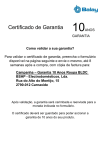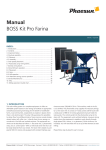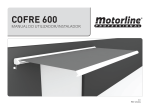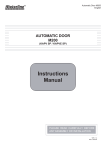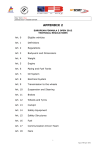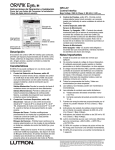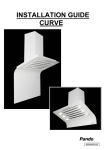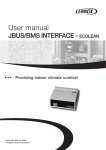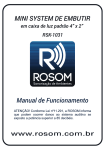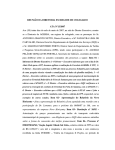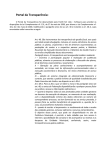Download SERVICE MANUAL CE-9W & CE-15W.
Transcript
SERVICE MANUAL CE-9W & CE-15W. June 2004 0 TABLE OF CONTENTS 0 TABLE OF CONTENTS ____________________________________________________1 1 ELECTRICAL CONNECTION _______________________________________________2 2 ELECTRICAL COMPONENTS ______________________________________________3 2.1 UNBALANCE SWITCH (IR): ____________________________________________4 2.2 UNBALANCE RELAY (R2) _____________________________________________4 2.3 ROTATION DIRECTION SWITCH (IS) ___________________________________5 2.4 ELECTRO-MAGNET COMPONENTS (E & IE): ____________________________6 2.5 DOOR SWITCH (IP) ___________________________________________________7 2.6 DOOR OPENING BUTTON (IAP-L) ______________________________________7 2.7 NTC DELAYER_______________________________________________________8 2.8 MOTOR (M) __________________________________________________________8 2.9 MOTOR CONNECTIONS BOX __________________________________________8 2.10 FUSES _______________________________________________________________9 2.11 THERMAL SWITCH (TM) ______________________________________________9 2.12 TIMER (TP) __________________________________________________________9 2.13 WIRING CONNECTIONS FOR THE MOTOR AND THE LID ________________10 3 TROUBLE SHOOTING ____________________________________________________12 4 SCHEMATICS AND TECHNICAL EXPLANATION OF THE MACHINE __________13 1 1 ELECTRICAL CONNECTIO N These machines have been designed and manufactured to be connected at 208-230/60/3. Important: Drum must spin clockwise, such is shown on pictures nº 1 and nº 2. If not, change 2 of the 3 phases on terminal block. If phases were not connected properly drum will spin counterclockwise and machine will not brake. However lid opening will be activated and accident could occur. Fig. nº1. Fig. nº2. 2 2 ELECTRICAL COMPONENTS C1 are the main contactors to spin and brake the machine. Both contactors come installed with two auxiliary contacts (N113015), one normally closed, one normally open. 4 A. Fuses “F” Ref : P184011 Relay “R1” Ref: Z683087 Relay “R2” Ref: Z683087 Auxiliar Contact. Ref: N113015 Terminal block Spin Contactor “C1”. Ref: X183011 Fig. nº3. Brake Contactor “C2” Delayer “NTC” Ref: N113007 Door switch “Ip” Door opening button “Iap” & cycle light “L” Door electro- magnet switch “IE” & Door electro- magnet “E”. Fig. nº4. Timer “Tp” Fig. nº5. 3 2.1 UNBALANCE SWITCH (IR): If the drum is moving out of control because of the weight of the clothes is not balanced or because of the shock absorbers are defective, the unbalance switch will stop the spin activating the R2 relay. Fig. nº 7 In order to continue the spin process, clothes must be balanced, the unbalance switch on position (Fig. nº 6) and the lid must have been open (Iap). Activator Unbalance switch (IR). Ref: N103038 Fig. nº6. 2.2 UNBALANCE RELAY (R2) R2 will be activated when IR is activated in order to stop the machine. R2 has a normally closed contact connected to C1 (spin contactor). That is why when R2 is activated C1 doesn’t receive power and machine is stopped. Check schematic. Unbalance Relay (R2) Ref: Z683087 Fig. nº7. 4 2.3 ROTATION DIRECTION SWITCH (IS) The rotation direction switch (Is) is inside of the motor connections box (Fig. 11) and it is activated by the clip on fig. 12. Ending Brown Rotation direction switch (Is). Ref: N105911 Red. White. Fig. nº11. Pista de rodadura. Clip In contact with the motor Fig. nº12. The purpose of this switch is to activate the brake contactor C2 and once drum is not moving activate the opening of the lid. 5 2.4 ELECTRO-MAGNET COMPONENTS (E & IE): It consists on an electro- magnet (E) and a switch (IE) fig. nº13. When (E) receives voltage the lid will open automatically. The connection on the solenoid of the electro-magnet is shown on picture nº 14. The door switch IE is a normally open contact that will close when lid is closed. If the switch is open, machine can not operate, preventing so that hydoroextractor will work when lid is open. Electro- magnet components (E + IE) Ref: N103028 Fig. nº13 . Door switch connection (IE). Solenoid connection (E) Red. White. Yellow. Blue. Purple. Fig. nº14. 6 2.5 DOOR SWITCH (IP) The door switch is a contact normally open that will close when lip is closed. This is to prevent that the drum is moving when lid is open. Fig. nº 16. Purple. Door switch “Ip” Ref: N103039 Brown. Fig. nº15 Fig nº16. 2.6 DOOR OPENING BUTTON (IAP-L) Iap will open the lid only when the drum is not moving, so before activating the timer. If you need to open the lid and the machine is already spinning, turn the timer until “O” position. In this way the machine will brake and lid will open. The button has pilot light (L) that will be on during the spin cycle. Ref.: Z213033 In case of failure or lack of power, the lid can be open manually pushing over the emergency lid opening switch located on the front side of the lid holder. Fig. nº 19. Emergency switch location to open the lid Fig. nº19. 7 2.7 NTC DELAYER NTC works like a timer before activating the brake contactor C2. Voltage doesn’t go through until NTC is heated up. When the spin time is over, C1 is disconnected but C2 will take a while to be activated thanks to the NTC. This action will prevent short-circuits in case both contactor worked at the same time. NTC 2.8 MOTOR (M) CE-9W; Ref.: N107701 240V – 415V 60Hz. ½ HP CE-15W; Ref :N117701 240V – 415V 60Hz. 1 HP Motor 2.9 MOTOR CONNECTIONS BOX On picture nº 21 is shown the box of a CE-15W where the motor connections are done. For the model CE-9W the box is eliminated and connection (triangle or star) is done on the same contactor. Connections Fig. nº21 8 2.10 FUSES Fuses 4 A. Ref: P184011 Fuse holders 2.11 THERMAL SWITCH (TM) Tm is an internal contact inside the motor normally closed that will open when the motor has overheated. When motor has cooled down contact will close automatically. Themal switch connections 2.12 TIMER (TP) If timer is placed on the “A” area. the hydorextractor will be working continuously. If not time from 0 to 15 min. will be selected. Timer (Tp). Ref: N113014 Range “A”. Brown White 9 2.13 WIRING CONNECTIONS FOR THE MOTOR AND THE LID There are two terminal connectors for the motor and the lid connections. Working on these connectors it is possible to check out components and it is not necessary to work on the component by itself. See fig. nº 28. Connector for the lid components Connector for the motor components Fig. nº28. A) Connector for the motor components On this terminal connector are connected the thermal switch of the motor (TM), the rotation direction switch (IS) and the unbalance switch (IR). On picture nº 29 it is shown the male connector and color of the wire on the electrical schematic. Connection for the rotation direction switch ( Is) Common.White Connection for the rotation direction switch ( Is). Red. Connection for the rotation direction switch ( Is). Pink. Connection for the thermal switch (TM). Black Connection for the thermal switch (TM). Yellow. Connection for the unbalance switch (IR). Purple. (Neutral) Connection for the unbalance switch (IR). Orange. Fig. nº29. 10 B) Connector for the lid components On this terminal connector are connected the electro- magnet (E) and the switch (IE), the door opening switch (Iap) and the timer (Tp). See the male connector and wiring colors on picture nº 30 Connection for the switch (IE). Yellow. Connection for the door opening switch (Iap). Orange. Connection for the door opening switch (Iap). Brown. Connection for the timer (TP). White. Connection for the switch (IE). Purple. Neutral connection for the electro-magnet (E) and for the pilot light(L). Blue. Connection for the pilot light (L).Pink. Figura nº30. Ground connection for the electro- magnet (E). Yellow-Green 11 3 TROUBLE SHOOTING NOTE: Before carrying out any operation (checking or repair) the machine must always be disconnected from the mains PROBLEM POSSIBLE CAUSE No power WAY TO CORRECT IT Check out fuses Close lid or replace close switch if it Lid is not closed is broken The motor does not start. Timer doesn’t work Replace The indicator lamp does Motor is too hot. Fuse will be not light up Terminal fuse of the motor has stopped activated automatically once motor the machine has cool down Contactor C1 is broken Replace Not equilibrated switch has been Deliver the clothes (weight) better The motor disconnects activated inside the drum immediately after starting. Shock absorvers are defective Replace It is probable that two phases were not Check out drum goes clockwise. If connected properly and spin is not not change phases. The brake does not work going in the right direcctoin Contactor C2 or delayer NTC defective Replace Motor continues working Timer defective when time is over Rotation direction switch defective IS Lid doesn’t open Door electro magnet defective E 12 Replace Replace Replace 4 SCHEMATICS AND TECHNICAL EXPLANATION OF THE MACHINE Review the information below looking at the schematic on next page. If lid is closed (IP closed) and timer is activated (TP closed) power will go through contact C2 and contact R2 (normally closed), activating C1 contactor. C1 contacts will be closed and motor M will start spinning clockwise. Light will come on and Relay R1 will be activated. If the clothes are not balanced IR will activate Relay R2 and R2 normally closed contact will be open so C1 will be deactivated and machine will stop. When time is over C1 is deactivated and power will go through C1 normally closed contact, through IS but it will not activate C2 immediately because NTC delays it. When C2 is activated the direction of the spin is counterclockwise, so that will brake the drum but will not spin, because IS will detect the change of the direction on the rotation and contact will change position. When IS contact has changed position, door- magnet E is activated opening the lid (IE). When drum is not moving and time was not selected, if we press the door opening button Iap E will be activated and lid will open. 13 14 15
















